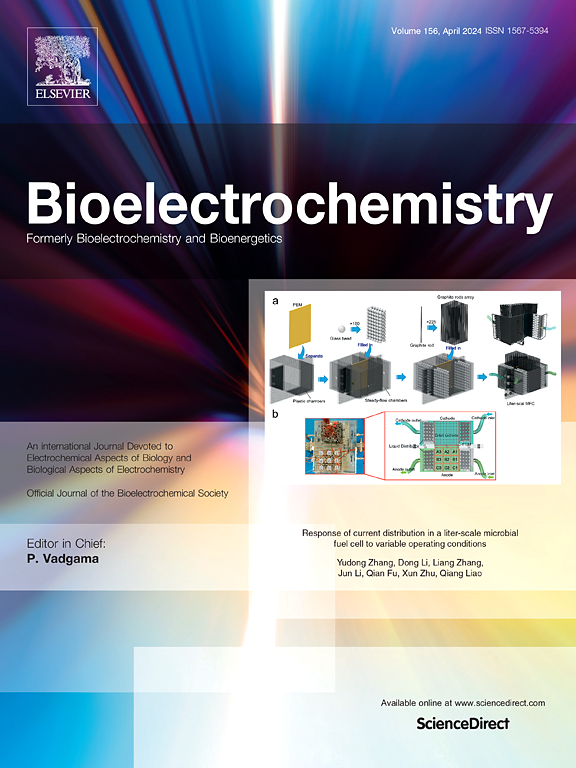获得灵敏度:一种基于辣根过氧化物酶和MoS2@black磷烯的草甘膦检测电化学生物传感器
IF 4.8
2区 化学
Q1 BIOCHEMISTRY & MOLECULAR BIOLOGY
引用次数: 0
摘要
草甘膦(Glyphosate, GLY)是应用最广泛的除草剂之一,其在食品样品中的残留对人类健康构成了威胁。开发一个监测系统可以帮助解决食品安全问题。本研究采用二硫化钼(MoS2)和黑磷烯(BP)纳米复合材料(MoS2@BP)和辣根过氧化物酶(HRP)对工作电极进行修饰,建立了一种新型的GLY检测电化学传感平台。采用水热法合成了MoS2@BP纳米复合材料,并通过扫描电镜、x射线光电子能谱和x射线衍射等不同方法研究了其特性。BP的存在提高了复合材料的电导率,增加了比表面积,而MoS2改善了复合材料的电化学性能,并对BP有保护作用。在电极表面修饰MoS 2 @BP有助于加速HRP的直接电子转移,增强了电化学响应。此外,HRP氨基酸残基的掺入显著增强了对GLY的识别,从而提高了该电化学传感器的选择性和灵敏度。传感器在0.118 ~ 20.65 nmol/L的线性浓度范围内有效工作,低检出限为0.0393 nmol/L (3σ)。此外,该传感器成功应用于实际玉米粉样品中的GLY检测,结果令人满意,显示了其在食品安全监测中的潜在应用前景。本文章由计算机程序翻译,如有差异,请以英文原文为准。

Garnering sensitivity: A horseradish peroxidase and MoS2@black phosphorene based electrochemical biosensor for glyphosate detection
Glyphosate (GLY) is one of the most widely used herbicides, and the presence of its residues in food samples poses a threat to human health. Developing a monitoring system could help address food safety concerns. This study presents an innovative electrochemical sensing platform to detect GLY, which employs molybdenum disulfide (MoS2) and black phosphorene (BP) nanocomposites (MoS2@BP) with horseradish peroxidase (HRP) for the working electrode modification. The MoS2@BP nanocomposite is synthesized using a hydrothermal method, and its characteristics are investigated through different methods including scanning electron microscopy, X-ray photoelectron spectroscopy, and X-ray diffraction methods. The presence of BP enhances electrical conductivity and increases specific surface area, while MoS2 improves the electrochemical properties of the composites and provides a protective effect on BP. The modification of MoS₂@BP on the electrode surface helps to accelerate the direct electron transfer of HRP with enhanced electrochemical responses. Furthermore, the incorporation of amino acid residues from HRP significantly enhances the recognition of GLY, thereby improving the selectivity and sensitivity of this electrochemical sensor. The sensor operates effectively within a linear concentration range from 0.118 nmol/L to 20.65 nmol/L, with a low detection limit of 0.0393 nmol/L (3σ). Furthermore, the sensor is successfully applied to detect GLY in real cornmeal samples with satisfactory results, demonstrating its potential applications in food safety monitoring.
求助全文
通过发布文献求助,成功后即可免费获取论文全文。
去求助
来源期刊

Bioelectrochemistry
生物-电化学
CiteScore
9.10
自引率
6.00%
发文量
238
审稿时长
38 days
期刊介绍:
An International Journal Devoted to Electrochemical Aspects of Biology and Biological Aspects of Electrochemistry
Bioelectrochemistry is an international journal devoted to electrochemical principles in biology and biological aspects of electrochemistry. It publishes experimental and theoretical papers dealing with the electrochemical aspects of:
• Electrified interfaces (electric double layers, adsorption, electron transfer, protein electrochemistry, basic principles of biosensors, biosensor interfaces and bio-nanosensor design and construction.
• Electric and magnetic field effects (field-dependent processes, field interactions with molecules, intramolecular field effects, sensory systems for electric and magnetic fields, molecular and cellular mechanisms)
• Bioenergetics and signal transduction (energy conversion, photosynthetic and visual membranes)
• Biomembranes and model membranes (thermodynamics and mechanics, membrane transport, electroporation, fusion and insertion)
• Electrochemical applications in medicine and biotechnology (drug delivery and gene transfer to cells and tissues, iontophoresis, skin electroporation, injury and repair).
• Organization and use of arrays in-vitro and in-vivo, including as part of feedback control.
• Electrochemical interrogation of biofilms as generated by microorganisms and tissue reaction associated with medical implants.
 求助内容:
求助内容: 应助结果提醒方式:
应助结果提醒方式:


